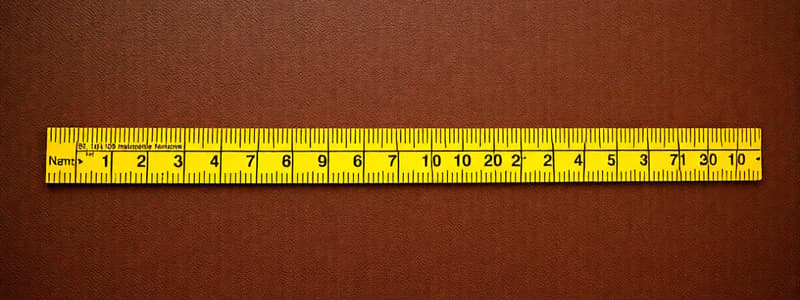Podcast
Questions and Answers
What does the magnitude of an earthquake specifically measure?
What does the magnitude of an earthquake specifically measure?
- The distance an earthquake's impact covers
- The speed at which seismic waves travel
- The energy released at the earthquake's source (correct)
- The shaking felt at a specific location
What is the primary function of seismographs in determining earthquake magnitude?
What is the primary function of seismographs in determining earthquake magnitude?
- To measure the depth of the earthquake focus
- To determine the epicenter of the earthquake
- To measure the relative damage caused by the earthquake
- To record the vibrations and wave amplitude of earthquakes (correct)
What is the key characteristic of the Richter scale's logarithmic nature?
What is the key characteristic of the Richter scale's logarithmic nature?
- Each decimal point increase represents 31.7 times energy increase.
- Each whole number increase represents a tenfold increase in energy
- Each whole number increase represents double the intensity
- Each whole number increase represents a tenfold increase in wave amplitude (correct)
How does an earthquake of magnitude 7 on the Richter scale compare to an earthquake of magnitude 5?
How does an earthquake of magnitude 7 on the Richter scale compare to an earthquake of magnitude 5?
If an earthquake has a magnitude of 4.0, and another has a magnitude of 6.0, how much more energy did the magnitude 6.0 earthquake release?
If an earthquake has a magnitude of 4.0, and another has a magnitude of 6.0, how much more energy did the magnitude 6.0 earthquake release?
Which of the following is a necessary adjustment when calculating an earthquake's magnitude using seismographs?
Which of the following is a necessary adjustment when calculating an earthquake's magnitude using seismographs?
What does a modern seismometer record precisely?
What does a modern seismometer record precisely?
Who initially developed the magnitude scale using seismograms from the San Andreas fault zone?
Who initially developed the magnitude scale using seismograms from the San Andreas fault zone?
Flashcards
Earthquake Magnitude
Earthquake Magnitude
A numerical measurement of the energy released at the source of an earthquake.
Richter Scale
Richter Scale
A logarithmic scale that measures the strength of earthquakes, where each increase of 1 represents a 10-fold increase in the amplitude of seismic waves.
Epicenter
Epicenter
The point on the Earth's surface directly above the focus of an earthquake, where the seismic waves originate.
Focus
Focus
Signup and view all the flashcards
Seismometers
Seismometers
Signup and view all the flashcards
Seismogram
Seismogram
Signup and view all the flashcards
Seismic Waves
Seismic Waves
Signup and view all the flashcards
Intensity
Intensity
Signup and view all the flashcards
Study Notes
Earthquake Magnitude and Intensity
- Earthquake magnitude quantifies the energy released at the earthquake's source, determined from seismograph readings.
- Magnitude values allow comparing earthquake strengths.
- The Richter magnitude scale, developed by Charles F. Richter, is crucial for measuring earthquake size.
- Richter calibrated the scale using seismograms from earthquakes along the San Andreas fault.
- A seismometer records ground vibrations from earthquakes.
- Seismometers, sensitive instruments, magnify ground motions, detecting earthquakes globally.
- Modern systems record ground motion precisely over specific time periods (0.1 to 100 seconds).
- The Richter scale is a logarithmic scale (base-10).
- Each whole number increase represents a tenfold increase in wave amplitude.
- A 6 on the Richter scale has 10 times the wave amplitude as a 5.
- A 7 has 100 times the wave amplitude compared to a 5.
- The energy released increases 31.7 times between each whole number value on the scale.
- Earthquake location, time, and magnitude are all derived from seismometer data.
Studying That Suits You
Use AI to generate personalized quizzes and flashcards to suit your learning preferences.
Description
Test your knowledge on earthquake magnitude and intensity, focusing on the Richter scale and the principles behind measuring seismic activity. This quiz covers key concepts like seismometers and the logarithmic nature of the Richter scale. Understand how earthquake strength is quantified and compared through various magnitudes.




